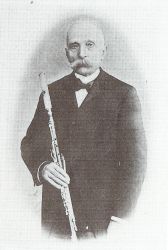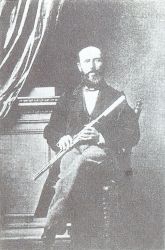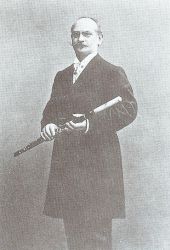
Detail of the 13-key flute by S. Koch (c.1825) shown below.

Viennese flutes were likely influenced by the London-made flutes of Richard Potter before 1800. Many early Viennese keyed flutes, e.g. by Franz Harrach (1750–1831), show features popularized by Potter: metal lined tuning heads, metal lined channels in the wooden blocks, and Potter's pewter plug keys throughout. But the Viennese had their own ideas about sound.
Characteristics of the archetypal 19th century Viennese-style flute are given below, and then illustrated by actual flutes. These characteristics are found, in particular, on the better quality flutes made by Stephan Koch (1772–1828) and Johann Joseph Ziegler (1795–1858) as well as on flutes of other Viennese makers (e.g. Schultz, Uhlmann, Stecher). Many of these features may be found on non-Viennese flutes as well. The firms founded by Koch and Zeigler were active, respectively, from c.1807 to past 1866, and from 1821 to past 1895. Zeigler's flutes were usually stamped "I. Ziegler".
Viennese style flutes were also made outside of Vienna. The firms of Euler and Heyl (Frankfurt a.M.) and Zimmermann (Liepzig, St. Petersburg, Moscow) supplied many of these instruments. While Italian flutes can vary greatly from one flute making center to another, a significant proportion of Italian flutes follow the Viennese model, for example flutes by the numerous Milanese makers, including U. Luvoni, Rampone, and Maino e Orsi, by Dal Seco of Venice, by Gaspari of Bologna, and by several makers in Torino.
I like to think that the relation of the sound of Viennese flutes to English flutes is somewhat analogous to the relation of the sound of early 19C Viennese pianos to English pianos. Viennese pianos were more colorful and more articulate, but less loud, than English pianos.
Some additional material on Viennese flutes may be found in Ardal Powell's The Flute, especially pages 150–152.
Early Viennese flutes are important because they are the flutes whose sounds were in the ears of Beethoven (what he could hear, anyway) and Schubert. I also find them excellent—while not the only alternative—for the flute music of Kuhlau. The flute below by S. Koch has pewter plug keys and shows an early form (soon to become obsolete) of the low B key, for the RH thumb. This flute exhibits a number of Koch's changes from the designs of his predecessors.

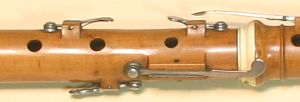

In his Flöten-Schule, Op.42 (Leipzig, 1826), the important German flutist A. B. Fürstenau recommends flutes by S. Koch and also by W. Liebel of Dresden. The flute shown in his illustrations is presumably by Koch, as they show a low B key for the RH thumb.


This slightly later flute by Koch has what became the standard form of the low b key (i.e. for LH4), the long C key (for RH1), and his embouchure hole.

The embouchure on the c.1815 boxwood Koch is oval. But the rounded rectangle (almost square), as seen on the slightly later instrument by Koch below, became the norm.


The metal lining for the channel in a block, and the metal lining for a hole under a key can be seen below. The hole bushings are relatively thick on this flute, and the key flaps are completely flat, so these keys can be used with flat leather pads or thin cork pads.
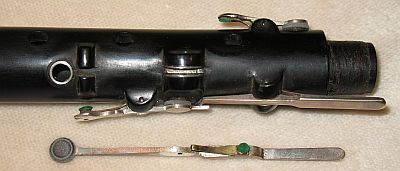
A foot joint to low a is found on the elegant flute below, as well as engraved rings and shell-shaped cups for the keys. Details are shown in the photo at the very top of this page.

There is evidence that this flute originally had a long extra lever, for the LH thumb, for the D# key, which was later removed. This would be a very early appearance of this key. See the paragraphs on the K. Stecher flute below for a description of this long key.
The spacing of the RH finger holes on Viennese-style flutes varies from maker to maker, and indeed from flute to flute by the same maker. Below is a good example of the unequal spacing of the RH finger holes. (Some Viennese flutes seem to have a slightly unequal spacing of the LH finger holes as well.) It may look like a minor matter, but it can require practice before the RH fingers learn to seal the holes on this flute well.

Sometime before 1820 we find flutes with long footjoints extending to low g (the lowest note of the violin) being made in Vienna. Sometimes these instruments are called "panaulons". Some of these instruments have the footjoint doubled back on itself with a bassoon-like construnction. On other flutes, the footjoint is straight. These flutes with low note g are not "alto flutes" in modern terminology, but rather are standard size flutes (concert flutes) with an extended foot joint. The low notes can work well and are great for special effects but are not responsive or agile enough to play serious violin music for the 4th string, in my opinion. The Dayton C. Miller Collection has a straight G-foot flute by Koch (DCM 0231) and an ivory G-foot flute with a curved foot attributed to Ziegler (DCM 0230).
There is confusion about who "invented" the G-foot flute and about the name panaulon. At least one source, the Allgemeine Encylopädie der Wissenshaften und Künste (Leipzig, 1838), defines the panaulon and attributes it to a Professor Langer in 1813 (with improvements by Wolfram and Ickler), but it is certainly not clear to me that it is the G-foot flute that is being discussed.
The G-foot flute was announced by Georg Bayr in 1813. Other sources say an inventor Trexler collaborated with Koch in 1815 to produce a 17-key panaulon. But a design for a G-foot flute already appears in a publication Saggio per costruire, e suonare un flauto traverso enarmonico the ha I suoni bassi del violino by Giovanni Batista Orazi, in Rome, in 1797! The depicted instrument has a footjoint doubled back on itself and pewter plug keys throughout. It is, however, not clear that such a flute was actually built at that time.

In 1823, Bayr published in Vienna a method, Practische Flöten-Schule, which depicts a straight G-foot flute made by Koch.
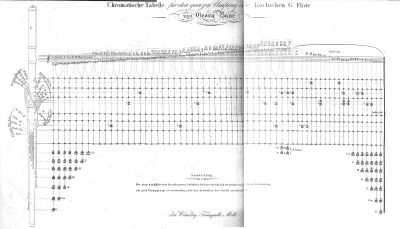
Here is a cleaned and rotated view of the flute illustrated by Bayr, followed by a photo of a straight G-foot flute made by Ziegler.


This instrument required incredibly extensive reconstrunction (work by Michael Hubbert). Wooden blocks had been broken off the surface of the flute. Pins and block linings were missing (almost every one of these was replaced); the head and the alternate G# key was missing as well. A new head to match the materials of the flute was made with bore and embouchure copied from a head from another instrument that I found to work well with the fragmentary panaulon. It plays very well now, with surprisingly easy and colorful high notes. (One of the long keys for the low notes is not sealing well, so the flute doesn't play below a.) Since it has a different head, there is no way to be sure it plays as it did when newly made, though it sounds and plays like other Viennese flutes to me, and the fingerings in Bayr's chart up to c'''' work. (The fingerings for b''' and c'''' require the low c'# and bb keys to be closed simultaneously, which cannot be done on many flutes.) I imagine that it is one of the few G-foot flutes in playing condition today.
A long foot joint may give some kind of back pressure to the air column and thus affect the tone, and the speech of the high notes. My feeling is that flutes with long foot joints have more body to their sound, but this is just my impression.
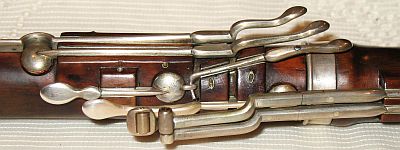
The keys for low a# and g are given to the LH thumb and equipped with rollers. The g key is about 45 cm long (almost 18"). The metal linings for the channel and pin holes in the wooden blocks are just discernable in the above photo.
Johann Sedlatzek (b.1789) played a G-foot Viennese flute in the premier of Beethoven's Ninth Symphonie in 1824, and continued to play it in England after moving there. The Hungarian virtuoso Adolf Terschak (1832–1901) is said to have played a sixteen-key G-foot flute, made for him by Zeigler in 1850, for his entire career.
One might guess that the G-foot flute developed as a jump from the B-foot instrument, and that flutes with an A-foot or a Bb-foot came later, when the G-foot was found too awkward, or the extra D# lever (see below) was desired.
Another flute by the S. Koch firm is shown below. This one was made in 1839, when the firm was managed by Fritz Koch.

The music critic Edward Hanslick (1824–1904) praised the "Ziegler flute" in 1874, saying that its excellence had prevented the adoption of the Boehm flute in Austria. A flute by Ziegler from this time is shown below.

The Doppler brothers Karl (1825–1900) and Albert Franz (1821–1883) were born in Poland but worked primarily in Hungary. The following image of Karl Doppler's flute is part of a CD cover (Doppleriade, Orfeo C 154 971 A). We may assume it was made by Ziegler. The foot joint extends to low a and it would have 16 keys if a duplicate G# key (not visible) is present.

(The Ziegler firm also supplied inexpensive flutes, like the boxwood flute with horn mounts shown below. While the flute is simple with only eight keys, it still has some features found on the better instruments including metal lined wooden blocks and metal bushed tone holes under keys.)

The flutist/composer Paul Wetzger illustrates and describes in his booklet Die Flöte of 1905 the types of flutes in use at that time. One of the types mentioned as an improvement on earlier simple system flutes is the Zeigler flute. For Wetzger, the duplicate keys are the important quality; he explains that the Ziegler flute has two closed-standing keys for each of C, Bb, G#, F, and D#, the second keys for Bb and D# being extra levers controlling a single hole for those notes. (He shows a B-foot flute and does not mention longer instruments.) This is exactly the configuration of keys on the flute by K. Stecher shown below. Click for a closeup of the keys on a similar flute by Maino e Orsi (Milan).

The extra D# lever is a long key with a touch for the left hand thumb. It can be awkward to use, but is occasionally very helpful when otherwise RH4 would have to move between opening the D# key and closing one or more of the keys on the footjoint for the low notes. For example, a slurred leap from c'# to e'''. It facilitates certain fingerings of some very high notes where the D# key must be open at the same time that the low C# key must be closed.

Karl Doppler's flute has this extra D# lever and it can also be made out on the flute in the photo of Adoph Burose (b.1858) in the Goldberg Collection of 1906. Burose was flutist with the Royal Hungarian Opera in Budapest c.1900. As Hungary was part of the Austro-Hungarian Empire at that time, it would be unusual did Burose and the Dopplers not play Viennese style flutes. (Coincidently, the most famous Viennese makers Koch and Zeigler were both born in Hungary.)
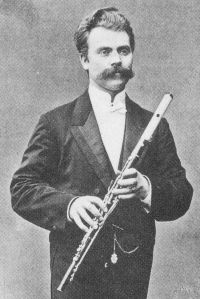
In addition to the extra D# lever, Burose's flute has a foot joint to low bb and appears to match in key configuration the 15-key flutes by Zimmermann and Maino e Orsi flutes shown below. Like the Stecher, these flutes have two keys for each note outside the D major scale.



The flute by Maino e Orsi, however, while basically Viennese-style, omits items I have suggested at the top of this page as characteristics of Viennese-style flutes. There are no pewter plug keys for the low keys. The tone holes under the closed-standing keys are not metal lined. Posts are screwed directly into the wood rather than being attached to plates.
It is likely that Mahler worked with long Viennese flutes with Bb- or A-foots in orchestras in Vienna since he included low bb's for the flute in a number of his works, including his Symphonies No. 3, 4, 5, and 6. (Boehm flutes with Bb-foots had been made but would have been very rare; even B-foot Boehm flutes were uncommon in Germany/Austria c.1900.)
The following anonymous flute was once an elegant instrument, but is now in extremely poor condition. The ring mounts are abalone shell.

It has most of the Viennese characteristics. The pads, which are either original or very old, are cork. It is clear that it once had an extra D# lever (now missing), because the plate for its mounting and a guide for the shaft may be seen to the left and to the right, respectively, of the F hole.
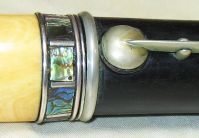
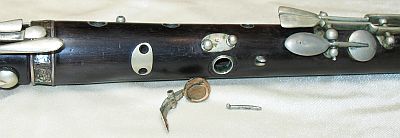
The flute by Rampone below has all the Viennese characteristics, including original (?) cork pads, though no extra D# lever.

Flutist Leonardo De Lorenzo (1875–1962) taught at the Eastman School of Music for many years. He relates in his My Complete Story of the Flute (1951) that when as as a young man he had made progess on his six-key flute, his parents sent to Milan for a 13-key flute with an ivory head. In all likelihood, that instrument would have matched the Rampone flute shown above in key configuration as well as style. This is the most common 13-key Viennese configuration (three open-standing keys for the B-foot, a single D# key, two keys for each of C, Bb, G#, F, and an e'''/d''' trill key). De Lorenzo played his 13-key flute professionally until he switched to the Boehm flute in 1903. Elsewhere in his book, he includes a description of what is supposed to have been an encounter in 1904 with a gentleman who still played a Viennese style simple system flute.
The circa 1920 Rampone catalog offers a large variety of Flauti Sistema Ziegler, including flutes with up to 19 keys and an A-foot.
